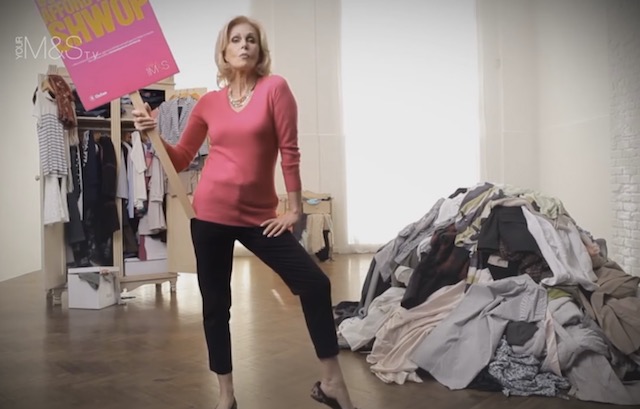
Have you heard of Shwopping?
Retailers like H&M and Marks & Spenser (M&S), in an attempt to “green up” their image, encourage shoppers to surrender unwanted clothes when they buy new ones. The old items are then supposedly resold, reused or recycled or donated to those in need via Oxfam.
I was shopping with my teenage daughters in H&M last summer when I first saw the signs for Shwopping. I found it an excellent idea, impressed that such a program exists.
I have been trying for years to declutter from my own shopping habit. That and the inevitable leftover clothing from the growth spurts of my three daughters means that I am always on the lookout for creative and useful ways to “get rid of” no-longer-wanted clothes.
However, as I become aware of the multitude of disturbing issues facing the fashion industry today, my attitude towards Shwopping is shifting.
I find the message behind it sneakily manipulative.
Shwopping programs let us swap old clothes for vouchers to be used toward our next purchase, claiming that “it’s a great way to clear the clutter and save at the same time.”
Clearing clutter from our closets is an important exercise as we attempt to regain control over our lives taken over by stuff. The shwopping message appeals to our sensibilities by tying their call for shopping with this positive message.
As a result, that pinch of guilt that I always feel when I buy clothes I do not really need carries less of a sting. This encourages me to continue life as before, indulging my shopping habit, while freeing me from troublesome feelings.
The unfortunate fact is that as we buy more and more fast fashion, we also tend to throw it out just after one season, if not one wear. Nearly 10,000 garments wind up in the landfill every five minutes! To keep the prices low, fast fashion clothes are mostly made from petrochemicals, polyester and nylon and are not biodegradable, which means they will be sitting in landfills for hundreds of years, emitting harmful gasses and accelerating global warming.
Shwopping’s partnership with Oxfam is certainly a constructive solution. Donating old clothes is better than throwing them out: we may be helping someone in need and giving another life to items that may otherwise go to a landfill.
The problem is that, while Shwopping aims to divert the one billion items from ending up in landfills every year, the campaign also diverts our attention from the reason behind our shopping addiction and our inability to resist a bargain, no matter how badly made or unnecessary.
Behind the appealing slogans, the campaign essentially inspires us not only to continue the mindless cycle of buying and purging more fast fashion, but to actually feel good about it.
And that, I find, is quite misleading.
By impressing upon us the fact that our unwanted clothes are now given to charity, we are made to feel as empowered and discerning consumers, buying from a company in step with the times, aware of the complicated issues in the fashion industry. Suddenly, while buying things we do not need, we help the environment through recycling and participating in changing the lives of those less fortunate through charity.
Shwopping attempts to make buying fast fashion meaningful:
“So next time you are clearing a space in your wardrobe, drop any unwanted clothes off in a Shwop box at your nearest M&S. It’s so easy. Shwopping: Ordinary clothes made extraordinary.”
Basically, if we discard our barely worn clothes not in a bin at home, but in the bin at M&S, it no longer feels like throwing it out. Now we actively participate in saving our planet.
In fact, nothing could be further from the truth.
When you take a bag of unwanted clothes to H&M or M&S you get a £5 voucher to spend. But here is the fine print: there is a minimum amount you have to spend in the store to get the voucher: £25 at H&M and £35 at M&S. There is also a time limit: you can only use the voucher in the same calendar month. In the end, we are really not saving any money; most likely we’ll be spending more than we intended to. To use the £5 voucher, we must spend at five to seven times that amount.
The shwopping scheme is simply a more elaborate and manipulative way to entice us to buy more and spend more! In reality this is neither about saving nor really about decluttering our lives, but rather a world-wide campaign to perpetuate business-as-usual and to-hell-with-the-consequences lifestyle.
The sign in H&M speaks for itself: “New stuff is coming in each and every day. So why not do the same.”
Will you do the same? I will not.
If we really are attracted to helping others and the environment through recycling, it will not be through buying more fast fashion.
To affect a meaningful change in any sphere of our lives, we need to start with changes in our own behavior. Here and here and here are some suggestions on how to start practicing conscious consumerism.
I will continue giving clothes to charity and decluttering my life, but I will no longer perpetuate the scary cycle of compulsive buying. I hope to regain control of my impulses and be a more mindful and selective consumer. The future of my children depends on it.
~
Author: Galina Singer
Image: Video Still
Editor: Travis May






Read 0 comments and reply